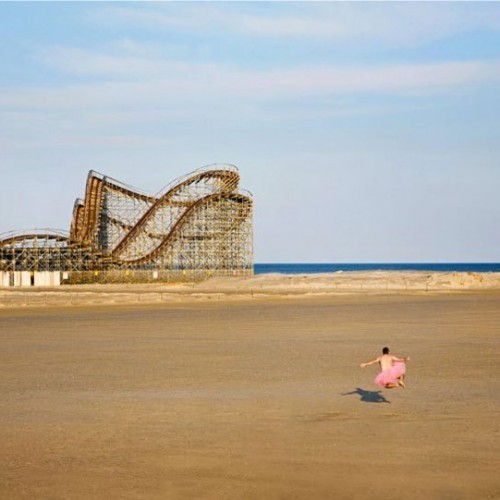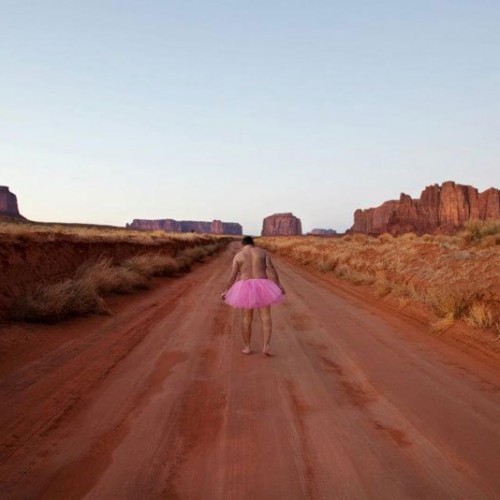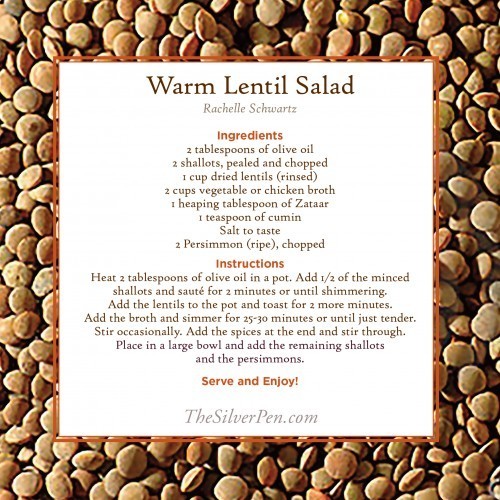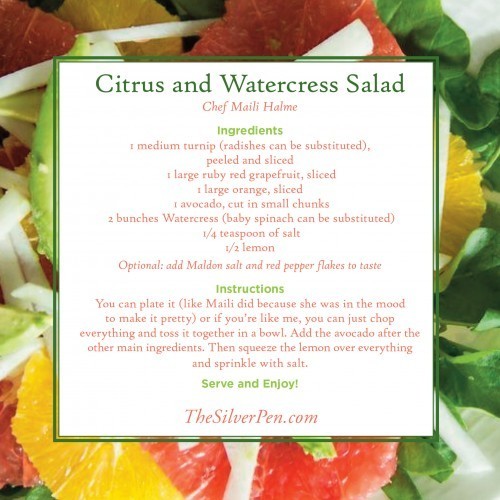Hollye Jacobs's Blog, page 24
January 31, 2014
Friday Photos: The Tutu Project


The Tutu Project
Many, if not most people have heard of The Tutu Project. If not, please allow me to introduce you to this extraordinary project. The mission is “to support the fund raising efforts of The Carey Foundation for women with breast cancer. We strive to bring laughter and understanding to a community that has endured far too much.” How great is that?!?
The Tutu Project™ began in 2003 as a lark when Bob Carey started photographing himself in a pink tutu. Even Bob says, “pretty crazy, right?”
The back story is that ten years ago Bob and his wife, Linda, moved to the East Coast. Six months after the move, Linda, was diagnosed with breast cancer. She beat it, only to have it recur in 2006. During these past nine years, he has been in awe of her power, her beauty, and her spirit. Oddly enough, her cancer has taught them that life is good, dealing with it can be hard, and sometimes the very best thing—no, the only thing—we can do to face another day is to laugh at ourselves, and share a laugh with others.
Talk about a Silver Lining!
Last September, through the sale of prints, Linda and Bob self-published a book called Ballerina. Not only is it a collection of his tutu images, but also shares many humorous stories about the adventures of a guy and his pink tulle.
Linda made it her goal to raise funds for women and their families who need financial support during their breast cancer journey. To help make her dream a reality, net proceeds from the sale of Ballerina will go directly to The Carey Foundation, a non-profit 501(c)3 organization that they established in 2012. There are so many expenses not covered by insurance and they are able to help with transportation to doctor appointments; wigs; lymphedema sleeves; childcare and counseling. To help distribute the funds they have partnered with CancerCare, a nationally run non-profit.
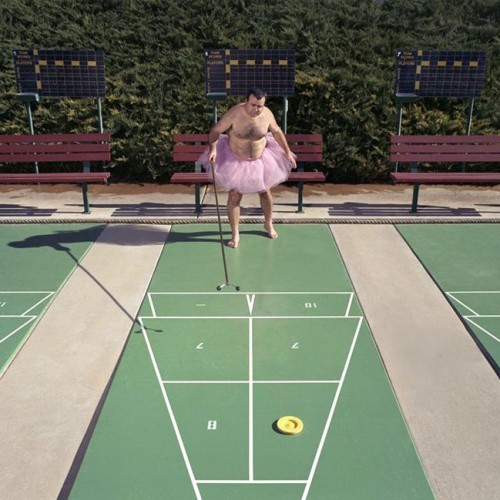


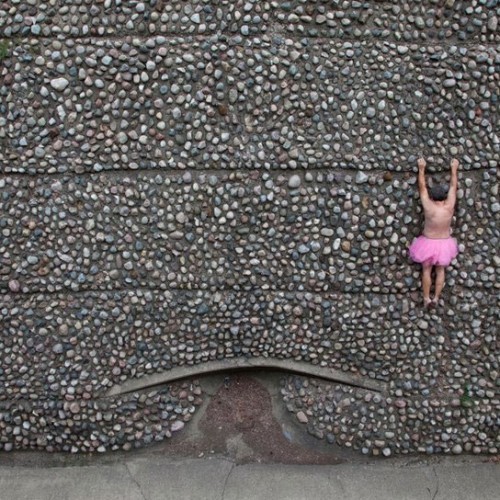 I hope that you have enjoyed these images as much as I have. It warms my heart to know that there are such good people putting such good into the world, especially in light of such a devastating diagnosis. This, my friends, is the ultimate Silver Lining!
I hope that you have enjoyed these images as much as I have. It warms my heart to know that there are such good people putting such good into the world, especially in light of such a devastating diagnosis. This, my friends, is the ultimate Silver Lining!
The post Friday Photos: The Tutu Project appeared first on The Silver Pen.
Facebook: https://www.facebook.com/TheSilverPen
Twitter: https://twitter.com/hollyejacobs
Google Plus: https://plus.google.com/1042044534272...
January 28, 2014
I Wanted a Perfect Ending Quote
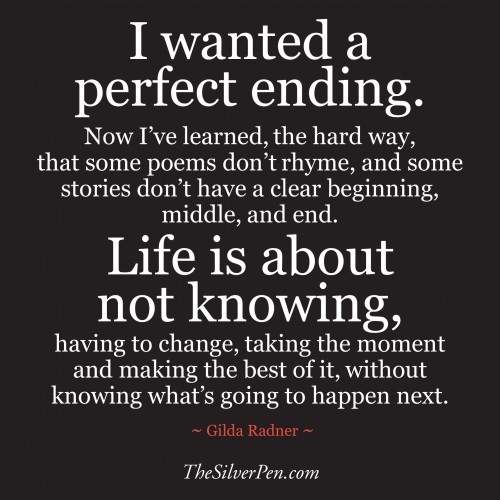

I Wanted a Perfect Ending Quote
Gosh, what a quote from Gilda Radner. I have read it and reread it and read it again. When I shared the quote with one of my friends, his immediate response was: “High Anxiety!” As in: Not Knowing = High Anxiety.
I used to feel the exact same way way. But then again, I used (pre-FBC) to be and feel a lot of things. After all, I liked to be in charge. I liked to plan things to the tee. Ha! The joke was certainly on me: the vegan-eating, marathon-running health nut who gets cancer!
Thanks to a health crisis of epic proportions, I too learned (the extra hard way, I might add) that some poems simply aren’t meant to rhyme…and that some stories do not have a clear beginning, middle, and end. Even after my diagnosis, I thought that one thing would stem from another in a logical fashion and that progress would happen linearly. I couldn’t have been more wrong.
I learned – probably from my bed or maybe even the bathroom floor – that life is indeed about not knowing, having to change, taking the moment and making the best of it, without knowing what’s going to happen next.
This lesson was one great big Silver Lining because now I no longer want a perfect ending, but rather enjoy life as it unfolds before my very eyes.
The post I Wanted a Perfect Ending Quote appeared first on The Silver Pen.
Facebook: https://www.facebook.com/TheSilverPen
Twitter: https://twitter.com/hollyejacobs
Google Plus: https://plus.google.com/1042044534272...
January 27, 2014
Musical Monday: Silver Girl


Silver Girl
Today I have an incredibly special and utterly personal post…a guest post that is. Both the post and the song have been written by a dear friend of mine, Stacey Fergusson. There are truly no words to express my profound gratitude with this spectacular honor.
——————-
When Hollye was diagnosed with FBC (f-bomb breast cancer) 3 years ago, I didn’t know what I could do to help. I followed her blog closely and saw her friends and family showing up the best they could with the skills and gifts they had. I asked myself “How can I show up for her?” so I began to write this song. As I read her daily posts, I was so moved and inspired by her courage, openness and her fabulous sense of humor. Hollye shares her experiences with wit, grace and grit and doesn’t hold back. She shines a light ahead for others who are on a similar journey. I wanted to honor her with a song as beautiful and inspirational as she is.
Once I had written the lyrics, I asked my friend producer/songwriter, JR Richards to bring it to life with music. I asked my friend, Oriana Sanders, to bring her clear, strong and elegant voice to the song. Oriana is also a cancer survivor, having been diagnosed with Hodgkins Lymphoma as a young mother. Our band, Vanaka (Vuh-NAH-kuh means gratitude) recorded Silver Girl in the spring of 2013 and last summer filmed a music video in Scotland. So grateful to have Hollye make a cameo appearance in the film.
The post Musical Monday: Silver Girl appeared first on The Silver Pen.
Facebook: https://www.facebook.com/TheSilverPen
Twitter: https://twitter.com/hollyejacobs
Google Plus: https://plus.google.com/1042044534272...
January 24, 2014
Friday’s Fixin’s: Warm Lentil Salad
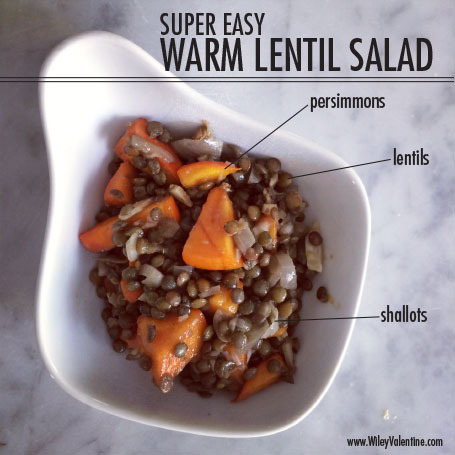

Warm Lentil Salad
Today’s recipe comes from my friend, Rachelle Schwartz of Wiley Valentine. Rachelle is an uber-talented artist, who also happens to be as kind as she is talented. I saw this recipe on her blog, tried it and fell in looooove. I’m a big fan of lentils, you see. Not only are they delicious and easy to prepare, but they are a – small but mighty – nutritional powerhouse.
They are a very good source of cholesterol-lowering fiber. Additionally, they are of special benefit in managing blood-sugar disorders since their high fiber content prevents blood sugar levels from rising rapidly after a meal (love this, because I always crave sugar after a meal!). Even more, lentils provide good to excellent amounts of seven important minerals, our B-vitamins, and protein—all with virtually no fat. The calorie cost of all this nutrition? Just 230 calories for a whole cup of cooked lentils. This tiny nutritional giant fills you up—not out. How’s that for a Silver Lining?!?
Thanks to Rachelle for letting me share this recipe!
Warm Lentil Salad
Rachelle Schwartz
Ingredients:2 tablespoons of olive oil2 shallots, pealed and chopped1 cup dried lentils (rinsed)2 cups vegetable or chicken broth1 heaping tablespoon of Zataar1 teaspoon of cuminsalt to taste2 Persimmon (ripe), choppedInstructions:Heat 2 tablespoons of olive oil in a pot. Add 1/2 of the minced shallots and sauté for 2 minutes or until shimmering.Add the lentils to the pot and toast for 2 more minutes.Add the broth and simmer for 25-30 minutes or until just tender. Stir occasionally.Add the spices at the end and stir through.Place in a large bowl and add the remaining shallots and the persimmons.
The post Friday’s Fixin’s: Warm Lentil Salad appeared first on The Silver Pen.
Facebook: https://www.facebook.com/TheSilverPen
Twitter: https://twitter.com/hollyejacobs
Google Plus: https://plus.google.com/1042044534272...
January 22, 2014
How to Make Stress Your Friend


How to Make Stress Your Friend
Last week – speaking at the Clinton Foundation Women’s Health Day – was stressful. I drove the poor HOTY crazy with my all-consuming stress. He said to me, “We’ve got to do something about this stress. It’s too much!” Poor Guy….
Now the Silver Lining was that I ended up having a great time and met some amazing people. Phew.
But this whole stress-business really got me thinking. Lo and behold, a good friend sent me this TED talk by Kelly McGonial on ”How to Make Stress Your Friend”! What incredible timing.
She is a health psychologist with a mission to make people happier and healthier. She confesses that something that she has been teaching the last 10 years is doing more harm than good. You see, for years she has told people that stress makes you sick. She turned stress into the enemy. However, she describes new research suggests that stress may only be bad for you if you believe that to be the case. HUH. How ’bout that?
So she asked, “Can changing the way you think about stress make you healthier?” YES is the answer. She goes on to say, “When you change your mind about stress you can change your body’s reaction to stress.” I’m so loving this…
So, her goal has changed from eliminating stress to making people “better at stress.” She now urges people to see stress as a positive. In fact, reveals a surprising mechanism for stress reduction: reaching out to others.
Instinctively, I actually did this. The week before my talk I reached out to some friends to rehearse – on a stage. Though I felt incredibly vulnerable and exposed, the work helped me immensely. One of my friends said, “use the stress as energy. Transform it to help you.” And you know what? It worked! Though I still need to work on corralling the stress, the Silver Lining is that I now know (& believe!) that it can be done!
Kelly McGonial’s TED video is below. Give yourself a gift and take the time to watch it. This message is a real life changer!
The post How to Make Stress Your Friend appeared first on The Silver Pen.
Facebook: https://www.facebook.com/TheSilverPen
Twitter: https://twitter.com/hollyejacobs
Google Plus: https://plus.google.com/1042044534272...
January 20, 2014
The Silver Lining Giveaway
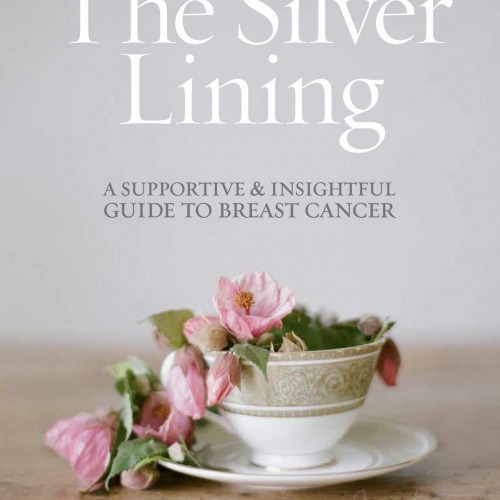

The Silver Lining Giveaway
Last week, I received an advanced copy of our book! The real thing. In hardback! My hands trembled and I burst into tears when I opened it. Finally, after a whole heckuvalot of blood, sweat and tears, I held our beloved project in our hands. It was one of the more exciting moments of my life and the ultimate Silver Lining.
March 18th is the official publication date, BUT Elizabeth Messina, my beautiful, talented co-author, and I are super excited to partner with Goodreads to give away a SIGNED advanced copy of The Silver Lining!
It’s super easy to enter. Just click on this link: https://www.goodreads.com/giveaway/show/77488-the-silver-lining-an-insightful-guide-to-the-realities-of-breast-cancer
The winner will be announced on February 1st.
Also, here is a sneak peak of some of the interior shots: http://issuu.com/atriabooks/docs/silver_lining_-_sample_pages_final
The post The Silver Lining Giveaway appeared first on The Silver Pen.
Facebook: https://www.facebook.com/TheSilverPen
Twitter: https://twitter.com/hollyejacobs
Google Plus: https://plus.google.com/1042044534272...
January 19, 2014
A Drought Emergency
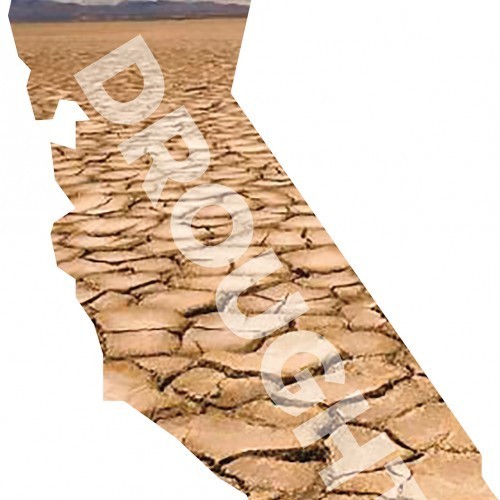

A Drought Emergency
Last week, when driving back and forth to Palm Springs, the HOTY and I could not get over how dry everything was. When I say dry, I mean D.R.Y. It was staggering, actually. Just as we were discussing it, we heard on the news that Governor Brown declared the state of California to be in a Drought Emergency. 2013 was actually the driest in history (history!) and 2014 is following a similar path.
In fact, the drought is bordering on unprecedented in some areas. According to Christopher Burt, weather historian at Weather Underground, the City of San Francisco has received only 2.12 inches of water so far in this water year. The driest water year on record was from 1850-1851, at 7.42 inches. So as of now, San Francisco is below half of the all-time record low (below half!).
Technically, a Drought Emergency is:
a concentrated management phase designed to marshal all available resources to respond to actual emergency conditions, to avoid depletion of water sources, to assure at least minimum water supplies to protect public health and safety, to support essential and high priority water uses and to avoid unnecessary economic dislocations. During this phase, mandatory restrictions are imposed on nonessential water uses. The objective of water use restrictions and other conservation measures during this phase is to reduce consumptive water use in the affected area by at least 15 percent, and to reduce total use to the extent necessary to preserve public water system supplies, to avoid or mitigate local or area shortages, and to assure equitable sharing of limited supplies. During a drought emergency, public water suppliers are authorized to institute water rationing, if mandatory restrictions prove insufficient to protect supplies and if approved by the Commonwealth Drought Coordinator.
Droughts are bad. Really bad. And dangerous. After all, we can’t live without water, of course. And plants can’t live without water, thereby sorely impacting the farming industry & our food supply. As if these aren’t bad enough, the thing that scares me to my core is the increased – emergent – threat of wildfires. We saw a fire on our way to/from Palm Springs and it was bad. Really bad. The drought that we are in is setting the stage for a devastating fire season.
I remember when I first moved to California from Chicago. I was the typical Midwestern who thought that the natural disasters to worry about were earthquakes. Yes, they are a concern, but the REAL natural disaster that California faces is wildfires. We have been evacuated twice since buying our home here nearly 10 years ago…and let me tell you, it’s awful. Being evacuated makes it hard to think clearly and my whole body shakes.
The Silver Lining of this threat is that it makes me appreciate each and every day (just in the same way that FBC did). Life can change in an instant. I know this all too well.
Another Silver Lining is that each and every one of us can help this situation. In fact, we can all do our part. It is time to rethink the way we use our water – every. single. day.
Below are some great suggestions from Save Our Water to jumpstart water conservation actions.
Inside the HomeLaundry RoomUse the washing machine for full loads only to save water and energyInstall a water-efficient clothes washer Save: 16 Gallons/LoadWashing dark clothes in cold water saves water and energy, and helps your clothes retain their color.KitchenRun the dishwasher only when full to save water and energy.Install a water- and energy-efficient dishwasher. Save: 3 to 8 Gallons/Load.Install aerators on the kitchen faucet to reduce flows to less than 1 gallon per minute.When washing dishes by hand, don’t let the water run. Fill one basin with wash water and the other with rinse water.Dishwashers typically use less water than washing dishes by hand.If your dishwasher is new, cut back on rinsing. Newer models clean more thoroughly than older ones.Soak pots and pans instead of letting the water run while you scrape them clean.Use the garbage disposal sparingly. Instead, compost vegetable food waste and save gallons every time.Wash your fruits and vegetables in a pan of water instead of running water from the tap.Don’t use running water to thaw food. Defrost food in the refrigerator.Keep a pitcher of drinking water in the refrigerator instead of running the tap.Cook food in as little water as possible. This also helps it retain more nutrients.Select the proper pan size for cooking. Large pans may require more cooking water than necessary.If you accidentally drop ice cubes, don’t throw them in the sink. Drop them in a house plant instead.Collect the water you use while rinsing fruit and vegetables. Use it to water house plants.BathroomInstall low-flow shower heads. Save: 2.5 GallonsTake five minute showers instead of 10 minute showers. Save: 12.5 gallons with a low flow showerhead, 25 gallons with a standard 5.0 gallon per minute showerhead.Fill the bathtub halfway or less. Save: 12 GallonsWhen running a bath, plug the bathtub before turning on the water. Adjust the temperature as the tub fills.Install aerators on bathroom faucets. Save: 1.2 Gallons Per Person/DayTurn water off when brushing teeth or shaving. Save: Approximately 10 Gallons/DayInstall a high-efficiency toilet. Save: 19 Gallons Per Person/DayDon’t use the toilet as a wastebasket.Be sure to test your toilet for leaks at least once a year.Put food coloring in your toilet tank. If it seeps into the bowl without flushing, there’s a leak. Fix it and start saving gallons.Consider buying a dual-flush toilet. It has two flush options: a half-flush for liquid waste and a full-flush for solid waste.Plug the sink instead of running the water to rinse your razor and save up to 300 gallons a month.Turn off the water while washing your hair and save up to 150 gallons a month.When washing your hands, turn the water off while you lather.Take a (short) shower instead of a bath. A bathtub can use up to 70 gallons of water.Outdoors
Most Californians think that they use more water indoors than outdoors. Typically, the opposite is true. In some areas, 50% or more of the water we use daily goes on lawns and outdoor landscaping. There are lots of ways to save water at home, but reducing the water you use outdoors can make the biggest difference of all. Here are a few easy ways to change the way you use water outside your home.
Water early in the morning or later in the evening when temperatures are cooler. Save: 25 gallons/each time you waterCheck your sprinkler system frequently and adjust sprinklers so only your lawn is watered and not the house, sidewalk, or street. Save: 15-12 gallons/each time you waterChoose a water-efficient irrigation system such as drip irrigation for your trees, shrubs, and flowers. Save: 15 gallons/each time you water.Water deeply but less frequently to create healthier and stronger landscapes.Put a layer of mulch around trees and plants to reduce evaporation and keep the soil cool. Organic mulch also improves the soil and prevents weeds. Save: 20-30 gallons/each time you water/1,000 sq. ft.Plant drought-resistant trees and plants. Save: 30- 60 gallons/each time you water/1,000 sq. ftHere are some additional resources:
State Government Drought Resources
DWR Drought PortalDaily Reservoir Storage SummaryCalifornia Reservoir ConditionsCalifornia Weather DataFederal Government Drought Resources
U.S. Drought PortalCentral Valley Project Water Supply InformationSo there we go. We will do our part. How about you?
The post A Drought Emergency appeared first on The Silver Pen.
Facebook: https://www.facebook.com/TheSilverPen
Twitter: https://twitter.com/hollyejacobs
Google Plus: https://plus.google.com/1042044534272...
January 17, 2014
Friday’s Fixin’s: Citrus And Watercress Salad
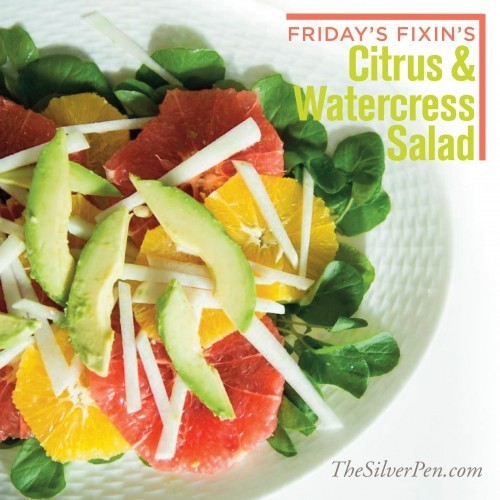

Citrus And Watercress Salad
We are truly blessed to live in California…for a number of reasons. For those who are living in the vortex this winter, I won’t torture you for telling you all of the reasons. I will, however, say that we have citrus and avocados all year long. Sorry. Truly. After all, I grew up in the Midwest…and I know.
So, many of you will be able to enjoy this yumma-licious salad now, but many others of you will be able to enjoy it next summer, which I hope that you will indeed do! In fact, when we started making it, Chef Maili wondered aloud, “Hmmm….how many readers will actually be able to make this now?!?” Well, we hope that many of you will indeed be able to make this because it is not only super yummy and incredibly easy, but also jam packed with healthy goodness.
Please enjoy as much as we did!
Citrus and Watercress Salad
Chef Maili Brocke
Ingredients
1 medium turnip (radishes can be substituted), peeled and sliced1 large ruby red grapefruit, sliced1 large orange, sliced1 avocado, cut in small chunks2 bunches Watercress (baby spinach can be substituted)¼ teaspoon of salt½ lemonOptional: add Maldon salt and red pepper flakes to tasteInstructions
You can plate it (like Maili did because she was in the mood to make it pretty) or if you’re like me, you can just chop everything and toss it together in a bowl. Add the avocado after the other main ingredients. Then squeeze the lemon over everything and sprinkle with salt.Serve and Enjoy!Be sure to check out Maili’s blog, The Maili Files and see more of Blue’s incredible photography.
The post Friday’s Fixin’s: Citrus And Watercress Salad appeared first on The Silver Pen.
Facebook: https://www.facebook.com/TheSilverPen
Twitter: https://twitter.com/hollyejacobs
Google Plus: https://plus.google.com/1042044534272...
January 16, 2014
Habits of Happy People


Habits of Happy People
Recently, on the Huffington Post, I came across the most wonderful article by about the Habits of Happy People. Just reading it made me happy. It is truly wonderful and I just felt compelled to share it here. I hope that it makes your day just a little bit happier!
Habits of Happy People by
Martin Seligman, the father of positive psychology, theorizes that while 60 percent of happiness is determined by our genetics and environment, the remaining 40 percent is up to us.
In his 2004 Ted Talk, Seligman describes three different kinds of happy lives: The pleasant life, in which you fill your life with as many pleasures as you can, the life of engagement, where you find a life in your work, parenting, love and leisure and the meaningful life, which “consists of knowing what your highest strengths are, and using them to belong to and in the service of something larger than you are.”
After exploring what accounts for ultimate satisfaction, Seligman says he was surprised. The pursuit of pleasure, research determined, has hardly any contribution to a lasting fulfillment. Instead, pleasure is “the whipped cream and the cherry” that adds a certain sweetness to satisfactory lives founded by the simultaneous pursuit of meaning and engagement.
And while it might sound like a big feat to to tackle great concepts like meaning and engagement (pleasure sounded much more doable), happy people have habits you can introduce into your everyday life that may add to the bigger picture of bliss. Joyful folk have certain inclinations that add to their pursuit of meaning — and motivate them along the way.
They surround themselves with other happy people. Joy is contagious. Researchers of the Framingham Heart Study who investigated the spread of happiness over 20 years found that those who are surrounded by happy people “are more likely to become happy in the future.” This is reason enough to dump the Debbie Downers and spend more time with uplifting people.They smile when they mean it. Even if you’re not feeling so chipper, cultivating a happy thought — and then smiling about it — could up your happiness levels and make you more productive, according to a study published in the Academy of Management Journal. It’s important to be genuine with your grin: The study revealed that faking a smile while experiencing negative emotions could actually worsen your mood.They cultivate resilience. According to psychologist Peter Kramer, resilience, not happiness, is the opposite of depression: Happy people know how to bounce back from failure. Resilience is like a padding for the inevitable hardship human beings are bound to face. As the Japanese proverb goes, “Fall seven times and stand up eight.”They try to be happy. Yep — it’s as simple as it sounds: just trying to be happy can boost your emotional well-being, according to two studies recently published in The Journal of Positive Psychology. Those who actively tried to feel happier in the studies reported the highest level of positive moods, making a case for thinking yourself happy.They are mindful of the good. It’s important to celebrate great, hard-earned accomplishments, but happy people give attention to their smaller victories, too. “When we take time to notice the things that go right — it means we’re getting a lot of little rewards throughout the day,” Susan Weinschenk, Ph.D. told The Huffington Post in May. “That can help with our moods.” And, as Frank Ghinassi, Ph.D. explains, being mindful of the things that do go your way (even something as simple as the barista getting your coffee order right) can make you feel a greater sense of accomplishment throughout the day.They appreciate simple pleasures. A meticulously swirled ice cream cone. An boundlessly waggy dog. Happy people take the time to appreciate these easy-to-come-by pleasures. Finding meaning in the little things, and practicing gratitude for all that you do have is associated with a sense of overall gladness.They devote some of their time to giving. Even though there are only 24 hours in a day, positive people fill some of that time doing good for others, which in return, does some good for the do-gooders themselves. A long-term research project called Americans’ Changing Lives found a bevy of benefits associated with altruism: “Volunteer work was good for both mental and physical health. People of all ages who volunteered were happier and experienced better physical health and less depression,” reported Peggy Thoits, the leader of one of the studies. Givers also experience what researchers call “the helper’s high,” a euphoric state experienced by those engaged in charitable acts. “This is probably a literal “high,” similar to a drug-induced high,” writes Christine L. Carter, Ph.D. “The act of making a financial donation triggers the reward center in our brains that is responsible for dopamine-mediated euphoria.”They let themselves lose track of time. (And sometimes they can’t help it.) When you’re immersed in an activity that is simultaneously challenging, invigorating and meaningful, you experience a joyful state called “flow.” Happy people seek this sensation of getting “caught up” or “carried away,” which diminishes self-consciousness and promotes the feelings associated with success. As explained by Pursuit-of-happiness.org, “In order for a Flow state to occur, you must see the activity as voluntary, enjoyable (intrinsically motivating), and it must require skill and be challenging (but not too challenging) with clear goals towards success.”They nix the small talk for deeper conversation. Nothing wrong with shootin’ the you-know-what every now and then, but sitting down to talk about what makes you tick is a prime practice for feeling good about life.A study published in Psychological Science found that those who take part in more substantive conversation and less trivial chit chat experienced more feelings of satisfaction. ”I wish I’d had the courage to express my feelings,” is one of the top five regrets of the dying – a sentiment that hints at the fact that people wish they’d spent less time talking about the weather and more time delving into what it is that makes their heart swell.They spend money on other people. Maybe money does buy happiness. A study published in Science found that spending money on other people has a more direct impact on happiness than spending money on oneself.They make a point to listen. “When you listen you open up your ability to take in more knowledge versus blocking the world with your words or your distracting thoughts,” writes David Mezzapelle, author of Contagious Optimism . “You are also demonstrating confidence and respect for others. Knowledge and confidence is proof that you are secure and positive with yourself thus radiating positive energy.” Good listening is a skill that strengthens relationships and leads to more satisfying experiences. A good listener may walk away from a conversation feeling as if their presence served a purpose, an experience that isclosely connected with increased well-being.They uphold in-person connections. It’s quick and convenient to text, FaceTime and tweet at your buddies. But spending the money on a flight to see your favorite person across the country has weight when it comes to your well-being. “There’s a deep need to have a sense of belonging that comes with having personal interactions with friends,” says John Cacioppo, Ph.D., the director of the Center of Cognitive and Social Neuroscience at the University of Chicago. Social media, while it keeps us in touch, doesn’t allow us to physically touch, which harvests the warm-and-fuzzies and even decreases feelings of anxiety.They look on the bright side. Optimism touts plenty of health benefits, including less stress, a better tolerance for pain and, as HuffPost Healthy Living recently reported, longevity among those with heart disease. When you choose to see the silver lining, you’re also choosing health and happiness. Seligman summed up perhaps the greatest characteristic of the optimist in one of his most acclaimed books, Learned Optimism : The defining characteristic of pessimists is that they tend to believe bad events will last a long time, will undermine everything they do, and are their own fault. The optimists, who are confronted with the same hard knocks of this world, think about misfortune in the opposite way. They tend to believe defeat is just a temporary setback, that its causes are confined to this one case. The optimists believe defeat is not their fault: Circumstances, bad luck, or other people brought it about. Such people are unfazed by defeat. Confronted by a bad situation, they perceive it as a challenge and try harder.They value a good mixtape. Music is powerful. So powerful, in fact, that it could match up to the anxiety-reducing effects of massage therapy. Over a three month period, researchers from the Group Health Research Institute found that patients who simply listened to music had the same decreased anxiety symptoms as those who got 10 hour-long massages. Choosing the right tunes could be an important factor, however, as a happy or sad song can also affect the way we perceive the world. In one experiment where researchers asked subjects to identify happy or sad faces while listening to music, the participants were more likely to see the faces that matched the “mood” of the music.Click here for a few of our favorite mood-boosting jams.They unplug. Whether by meditating, taking a few deep breaths away from the screen ordeliberately disconnecting from electronics, unplugging from our hyper-connected world has proven advantages when it comes to happiness. Talking on your cell could increase your blood pressure and raise your stress levels, while uninterrupted screen time has been linked to depression and fatigue. Technology isn’t going away, but partaking in some kind of a digital detox gives your brain the opportunity to recharge and recover, which — bonus — could increase your resilience.They get spiritual. Studies point to a link between religious and spiritual practice and mirth. For one, happiness habits like expressing gratitude, compassion and charity are generally promoted in most spiritual conventions. And, asking the big questions helps to give our lives context and meaning. A 2009 study found that children who felt their lives had a purpose (which was promoted by a spiritual connection) were happier. Spirituality offers what the 20th-century sociologist Emile Durkheim referred to as “sacred time,” which is a built-in, unplugging ritual that elicits moments of reflection and calm. As Ellen L. Idler, Ph.D., writes in “The Psychological and Physical Benefits of Spiritual/Religious Practices,”: The experience of sacred time provides a time apart from the “profane time” that we live most of our lives in. A daily period of meditation, a weekly practice of lighting Sabbath candles, or attending worship services, or an annual retreat in an isolated, quiet place of solitude all of these are examples of setting time apart from the rush of our everyday lives. Periods of rest and respite from work and the demands of daily life serve to reduce stress, a fundamental cause of chronic diseases that is still the primary causes of death in Western society. Transcendent spiritual and religious experiences have a positive, healing, restorative effect, especially if they are “built in,” so to speak, to one’s daily, weekly, seasonal, and annual cycles of livingThey make exercise a priority. A wise, albeit fictional Harvard Law School student once said, “Exercise gives you endorphins. Endorphins make you happy.” Exercise has been shown to ease symptoms of depression, anxiety and stress, thanks to the the various brain chemicals that are released that amplify feelings of happiness and relaxation. Plus, working out makes us appreciate our bodies more. One study published in the Journal of Health Psychology found that exercise improved how people felt about their bodies — even if they didn’t lose weight or achieve noticeable improvements.They go outside. Want to feel alive? Just a 20-minute dose of fresh air promotes a sense of vitality, according to several studies published in the Journal of Environmental Psychology. “Nature is fuel for the soul, “ says Richard Ryan, Ph.D, the lead author of the studies. “Often when we feel depleted we reach for a cup of coffee, but research suggests a better way to get energized is to connect with nature.” And while most of us like our coffee hot, we may prefer our serving of the great outdoors at a more lukewarm temperature: A study on weather and individual happiness unveiled 57 degrees to be the optimal temperature for optimal happiness.They spend some time on the pillow. Waking up on the wrong side of the bed isn’t just a myth. When you’re running low on zzs, you’re prone to experience lack of clarity, bad moods and poor judgment. “A good night’s sleep can really help a moody person decrease their anxiety,” Dr. Raymonde Jean, director of sleep medicine and associate director of critical care at St. Luke’s-Roosevelt Hospital Center told Health.com. “You get more emotional stability with good sleep.”They LOL. You’ve heard it before: Laughter is the best medicine. In the case of The Blues, this may hold some truth. A good, old-fashioned chuckle releases happy brain chemicalsthat, other than providing the exuberant buzz we seek, make humans better equipped to tolerate both pain and stress. And you might be able to get away with counting a joke-swapping session as a workout (maybe). “The body’s response to repetitive laughter is similar to the effect of repetitive exercise,” explained Dr. Lee Berk, the lead researcher of a 2010 study focused on laughter’s effects on the body. The same study found that some of the benefits associated with working out, like a healthy immune system, controlled appetite and improved cholesterol can also be achieved through laughter.They walk the walk. Ever notice your joyful friends have a certain spring in the step? It’s all about the stride, according to research conducted by Sara Snodgrass, a psychologist from Florida Atlantic University. In the experiment, Snodgrass asked participants to take a three-minute walk. Half of the walkers were told to take long strides while swinging their arms and holding their heads high. These walkers reported feeling happier after the stroll than the other group, who took short, shuffled steps as they watched their feet.Any of these points resonate with you? What are some of your habits that make you happy?
The post Habits of Happy People appeared first on The Silver Pen.
Facebook: https://www.facebook.com/TheSilverPen
Twitter: https://twitter.com/hollyejacobs
Google Plus: https://plus.google.com/1042044534272...
January 6, 2014
Safety During Chemotherapy Treatment
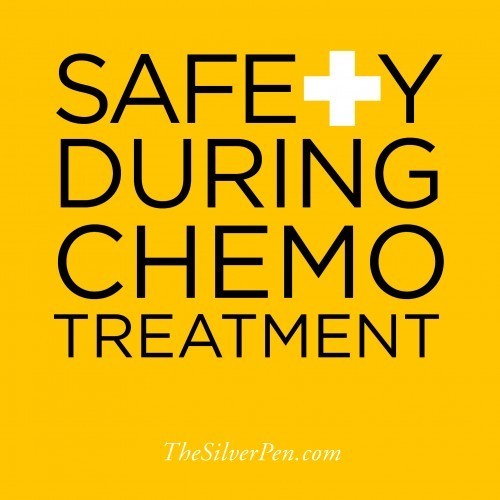

Safety During Chemotherapy Treatment
This week, I heard an absolutely heart-breaking, tear inducing, mind-numbing story involving a person who had just finished a chemo treatment. Apparently, this person had a bad reaction to a medication after leaving the cancer center and this reaction caused a fatal car crash. Unimaginable and truly horrific, I know.
This incident automatically made me think about my own situation. After surgery and during chemo, I drove as often as I could because it gave me a feeling of normalcy and independence (that FBC robbed from me every chance it had); however, there were multiple times when I couldn’t remember where I lived. Literally. I did not know how to get home. The Silver Lining was that I remembered my address and was able to put it into my GPS system to deliver me safely at my home. I realize that use of the word “safe” is tenuous.
Another time, I remember swerving across 3 lanes of traffic to throw up on the side of the road (rather than all over my steering wheel and front window). Many people honked at me, but the Silver Lining was that I made it to the side of the road “safely” (again with the use of the word safe).
Hearing about this fatal car crash sent shivers up and down my spine…because that could just have easily been me. Wow. As much as I wanted (needed!) the independence and freedom of driving myself, the truth of the matter is that driving after surgery or while taking any medications has the potential to be dangerous. I’m sorry to be the bearer of bad news, but you know that I always tell you the truth.
I wish that I had heard this information when I was sick because I know that I would have made different decisions.
So, what to do? NOW is the time to engage your resources. As I’ve said so many times, cancer doesn’t just happen to you. It happens to your family, your friends and your community. So many people are looking for opportunities to help you, but may not know how. Please oh please, engage them. Ask them to drive you to and from appointments…to the grocery store…to the library. They will feel so glad to be asked to help, and the best Silver Lining of all is that you (and your fellow drivers) will be kept safe!
You can still feel independent by asking your “driver” to simply drop you off and then pick you up at a designated time. Assure them that as much as you appreciate their driving, that you need the time by yourself to shop or go to a movie, etc.
The most important thing is to stay safe. Always and in all ways!
The post Safety During Chemotherapy Treatment appeared first on The Silver Pen.
Facebook: https://www.facebook.com/TheSilverPen
Twitter: https://twitter.com/hollyejacobs
Google Plus: https://plus.google.com/1042044534272...

